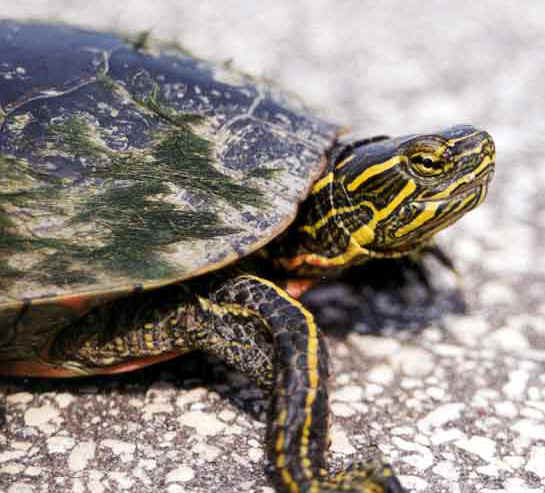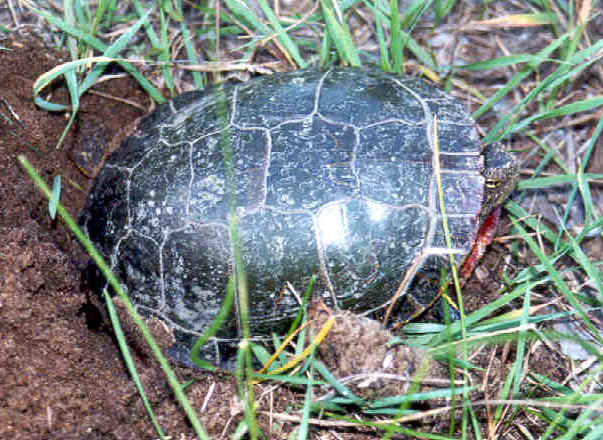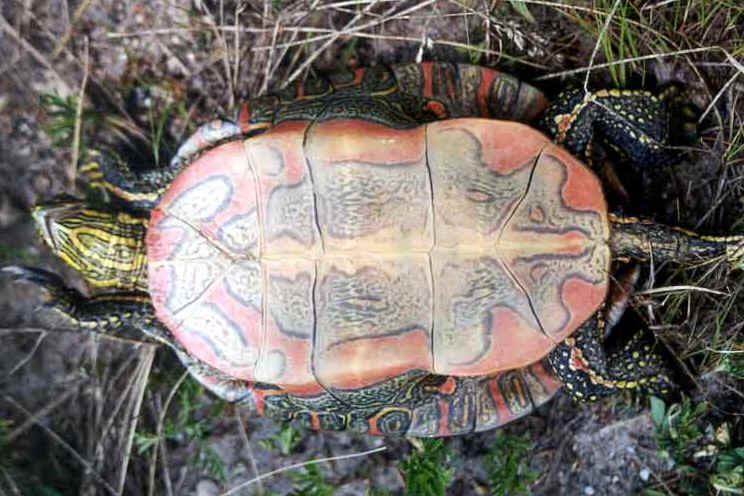|
Home
The Herps of
La Crosse
Living With Herps
Easy Herp Monitoring
Herps as Pets
General Herp Info
Suggested Reading and Bibliography
Links
About Me and Contact Info
| |
Painted
Turtle
(Chrysemys
picta)
 

Pictured
above: Painted Turtle head pattern (top left). Female Painted Turtle
excavating a nest to deposit her eggs (top right). Painted Turtle
plastron, or bottom shell (bottom).
Description:
Painted
Turtles are a small to medium-sized turtle, with adults attaining a carapace (or upper shell
surface) length of 3.5 to 7 inches
(males generally being smaller than females). Because it is an aquatic
turtle, the Painted Turtle's carapace is flat and
smooth. It is olive with a barely discernable pattern of lines
interiorly, while the edge has a reddish tinge.
The plastron (or lower shell surface) of this turtle is orange or red
and covered with black, gray, or tan markings (pictured above).
A Painted Turtle's head, legs, and tail are olive with bold yellowish,
and sometimes, reddish stripes (pictured above).
There are two sub-species of painted turtle found in the Upper
Midwest. The Midland painted turtle (Chrysemys picta marginata)
has red stripes along its head and forelegs. Furthermore, their
plastrons are normally yellow, or orangish-yellow with a thin dark stripe
down the center that covers less than half of the shell surface. The
other sub-species, the Western painted turtle (Chrysemys picta belli)
does not have red stripes along the head or forelegs. In addition, the
plastron of the Western painted turtle is usually reddish orange with a
central stripe that covers more than half of its'
plastron, occasionally
following the seams of each scute out to the margin of the shell. The
individuals pictured above are the western sub-species (C. picta belli).
All painted turtles are members of the
family Emydidae.
Habitat/Ecology:
Painted Turtles are found in many
types of water bodies, including lakes, ponds, marshes, swamps, rivers, and
river impoundments. They seem to prefer soft bottoms and dense aquatic vegetation.
In addition, because
they often bask, they also require many logs or rocks to climb out of the
water onto. Generally they do
not stray far from water, unless nest-building (usually late May through
part of July), at which time they may
travel over half a mile to find suitable nesting grounds, and during this
time, female turtles are very susceptible to predators, desiccation, and
road-related mortality. Once they
reach the appropriate site, the female will dig a flask-shaped hole with her
hind feet, and deposit up to 20 elliptical eggs. Some females will
even lay two clutches of eggs per season. These eggs generally begin
to hatch in mid-August. It has been reported that egg clutches laid
late in the year may will hatch, but the young will remain in the nest
(resisting freezing) and emerge the following spring.
Painted
turtles will consume a wide variety of prey-types, including invertebrates, fish,
carrion, and even a significant amount of aquatic vegetation, such as algae and duckweed.
Painted turtles probably over-winter in bodies of water (such as rivers)
that do not freeze and remain well oxygenated throughout the colder
months. In areas like the La Crosse River Marsh (located near Myrick
Park), I have seen many painted turtles in shallow, stagnant water
throughout the spring/summer. It would be my guess that these
individuals then migrate to the La Crosse River (which runs through the
marsh) to hibernate. Vogt (1981) reported finding several species of
map turtle hibernating behind wing dams in the main channel of the
Mississippi River. It is not far-fetched to speculate that painted
turtles living in the main channel of this river do likewise.
While
young painted turtles fall victim
to many predators (including birds, fish, and mammals), the only true threat
to adults are humans.
Remarks:
While
they can often be seen from a distance basking on logs or rocks, these
turtles are wary and usually escape into the water at sight of people.
If captured, painted turtles retract into their shells and may hiss
with mouths agape or urinate. They
may also bite if the opportunity presents itself.
Painted Turtles seem to withstand human disturbances to their environment
better than many other aquatic turtles.
Painted turtles are
commonly found throughout the La Crosse area. I have witnessed them on
many occasions within the La Crosse River Marsh as well as near Green Island and
Goose Island. They are probably the most commonly seen turtle in the
La Crosse area, and, along with the snapping turtle, may be the most common
turtle in the Upper Midwest.
Back
to Reptiles Page
|